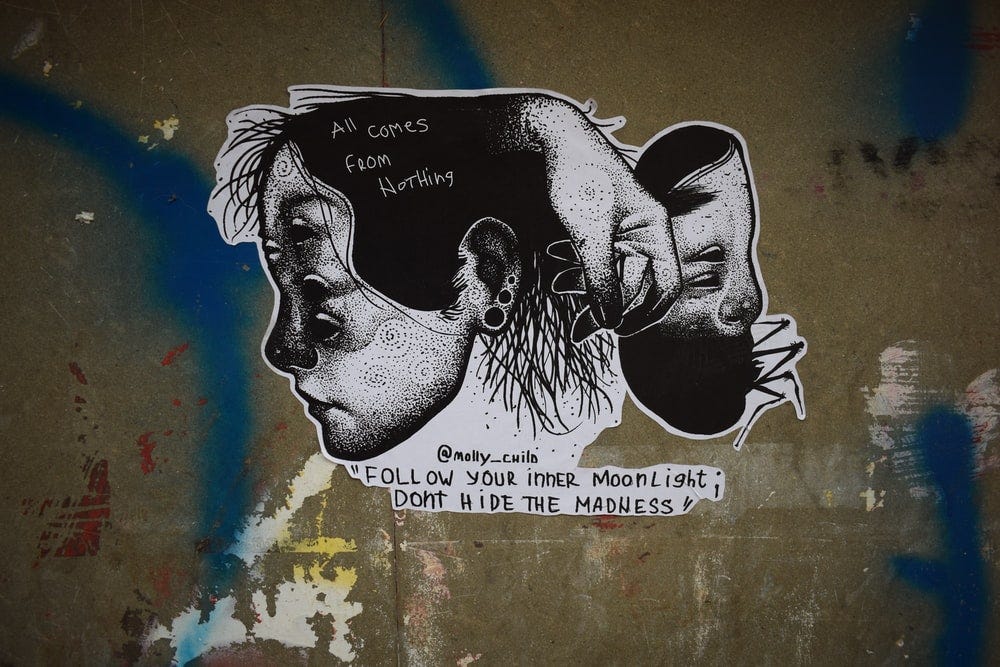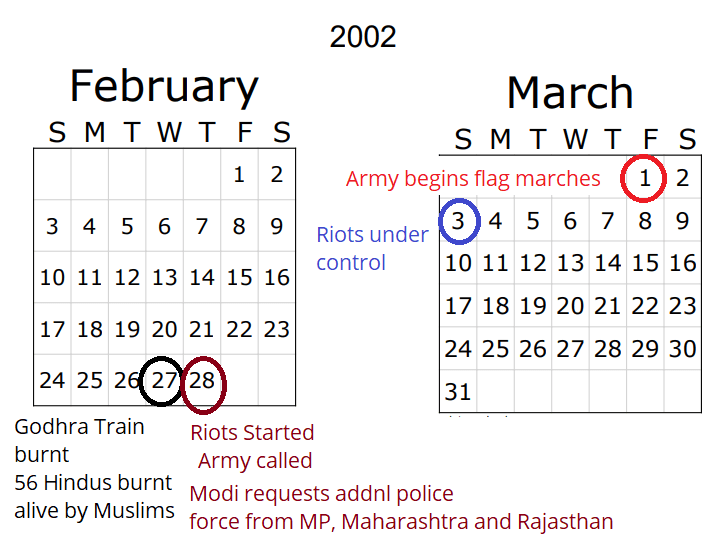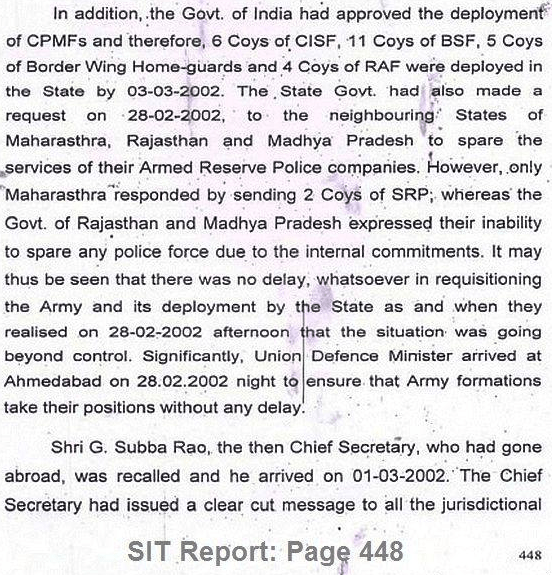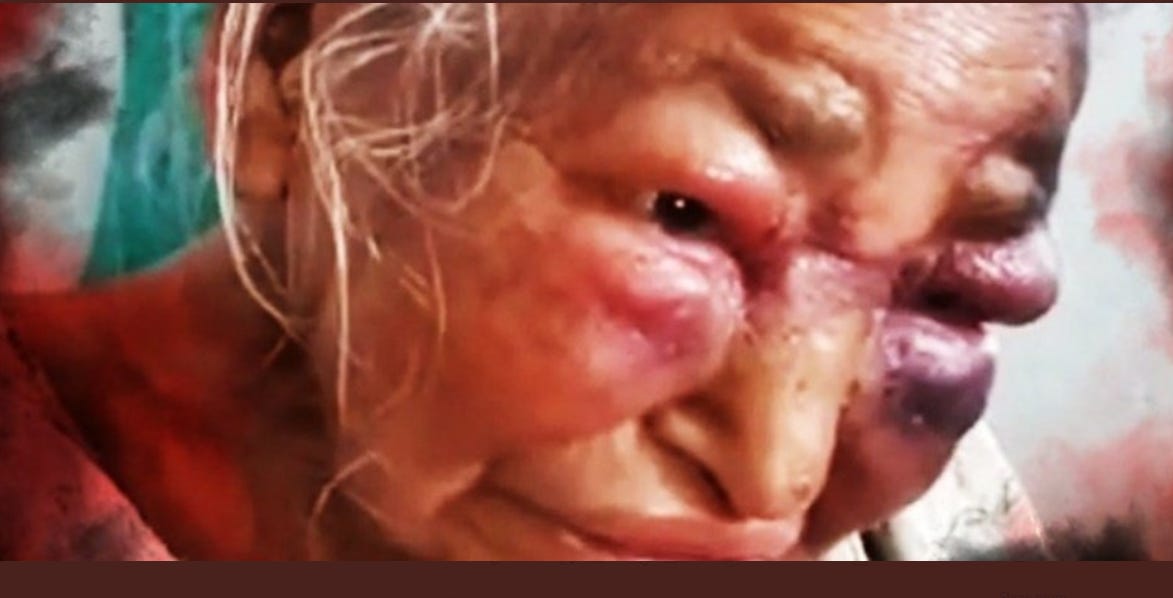Insightful newsletter of Drishtikone: Issue #255 - Gujarat Riots - The Facts and the Truth
Art of deception is when facts are right in front of you and yet you draw completely opposite conclusions to the reality. Gujarat 2002 and connected events fall in that category. Lets learn the truth.
Photo by Marija Zaric on Unsplash
“Where are the people?” resumed the little prince at last. “It’s a little lonely in the desert…” “It is lonely when you’re among people, too,” said the snake.” ― Antoine de Saint-Exupéry, The Little Prince
How is it that the same players, with the same strategy, the same tactics, the same ploys, the same stories, and the same accomplices keep fooling us again and again…. and again?
Thankfully, they chose to do this against the same adversary.
Narendra Modi.
He was to be taught a lesson. A Lesson that he would never ever forget.
They succeeded.
He didn’t.
Today, let us go into the details and facts of what happened in Gujarat in 2002 during these fateful days. Events that set things in motion that would uproot every scheming, collaborating, and treasonous force from India.
A lesson to never ever forget for generations to come.
19 years back today
It was a Friday today. March 1st. A bloody riot had started a day back. Today, the Army was brought in.
The man who was handling the worsening situation was battling not just the emotions and the machinations of many unscrupulous people - within the country and outside; but also a media that loved the sight of blood. The honchos of that media were playing their own game. Provoking and directing people to violence.
Despite his entreaties and warnings, they would not cease in their Machiavellian games.
The first incidences of violence happened on the 28th around noon. First three victims - Hindus. By 2.00 PM a request was sent to the Central Government for bringing the Army in.
2 hours.
28th February - the troops land in Gujarat.
Along with George Fernandes, the Indian Defence Minister. Despite the dark clouds hovering on the border.
George Fernandes and Modi meet at night on the 28th. The times were tough and tricky. Indian Army could not spare much force. Whatever was available was sent forthwith.
Next morning - March 1st. The army starts marching in.
Here is the timeline.
February 27th, 2002: The train was set on fire and 56 Hindus burned by Muslims in a pre-planned way while the mob stoned them to prevent them to jump out of the burning train (source)
February 28th, 2002: The Riots started. Modi government called the Army and sent requests to three Congress governments – Madhya Pradesh, Maharashtra, and Rajasthan for the additional police force. Only Maharashtra sent 3 companies of CRPF. MP and Rajasthan did not send any. (source)
March 1st, 2002: Army began flag marches and shoot at sight orders (Source)
March 3rd, 2002: the Riots were brought under control (Source)
On 28th February, not only did Modi call the Army, but he also fervently wrote to the Chief Ministers of Madhya Pradesh, Rajasthan, and Maharashtra to send in their police force for help.
All were Congress-ruled states.
None sent a single constable.
Here is the part of the Special Investigation Team (SIT) constituted under the Supreme Court which probed into the riots and gave their report – where the requests sent by Modi to the MP, Maharashtra and Rajasthan state governments on February 28th 2002 have been discussed. (courtesy – Guruprasad.net)
Left alone. Hounded. And, targeted.
Modi fought against all odds to stop a riot that was turning nasty.
The riots were contained state-wide within 2 days. Across one of the largest states in India.
Just for context, Gujarat is larger than Pennsylvannia and South Carolina put together in the area and has a population larger than the populations of the two most populated states in the US – California and Texas put together (37.25 mn – CA, 25.145 – TX in 2010 and Gujarat – 62.7 mn in 2013)!
But why did the riot even happen?
For this, we will need to go back to February 27th.
The Godhra train burning.
The commission found that local Muslims at the Aman guest house in Godhra had hatched a conspiracy to burn the coaches of the Karsevaks who were traveling in coach S-6.
To operationalize this plan, these local Muslims purchased 140 liters of petrol from a nearby petrol pump on the night of 26 February 2002. The petrol was transported in a green tempo by Imran Sheru, Hasan Charkha, Jabir Behra, and Mehmood Khalid, and some others and kept in the room of a guest house.
The train was late the next morning. They changed their strategy and at around 8 am spread a false rumor that a Muslim girl (Sofiabanu Shaikh) had been abducted into the train by karsevaks.
When a crowd of Muslims gathered to attack the train, the culprits used this opportunity to set the coach on fire. Shaikh’s story, when probed by the Commission, was not consistent and was clearly fed to her after the fact.
On February 27th, Hasan Lala entered the S-6 coach after forcibly opening the vestibule between S-6 and S-7 coaches and entered the coach from the rear. He threw burning rags to set the coach on fire. The mob was meanwhile pelting stones to prevent the passengers from moving out of the burning train coach!
So the main conspirators, along with thousands of Muslims from the Signal Falia area, committed a crime that is unimaginable in scale and ferocity.
This was the main finding from Noel Parmar, the Dy SP who contributed to the most extensive investigation by Supreme Court judges - KG Shah and GT Nanavati.
The plan was hatched by Salim Panwala, Razak Kurku, and half a dozen others including Muslim cleric from Godhra Maulvi Husain Haji Ibrahim Umarji.
As per the report “setting fire to the train was part of a “larger conspiracy” to “instill a sense of fear” in the administration and create “anarchy” in the state”.
Godhra train burning was a conspiracy by the Muslims in Godhra. Done to spark riots in an area that was known for riots every few years for over a century.
The commission that looked into the Godhra train burning incident of February 27, 2002, and the subsequent riots in Gujarat comprised two retired judges – KG Shah (retired Gujarat High Court judge)and GT Nanavati (retired Supreme Court Judge).
The final report was submitted by the Commission to the Gujarat Government on November 18th, 2014. It was tabled in Gujarat’s legislative assembly on December 11, 2019. The Nanavati-Mehta Commission report had completely exonerated Narendra Modi for the 2002 Gujarat riots.
This report is significant in its scope and findings and lays to rest all speculative and ideological assertions made by Modi-haters – in India and globally – who peddled in bigotry and Hinduphobia.
It is instructive to remember that the Commission has heavily depended on the investigation by the police, which was led by DIG Rakesh Asthana (who is now IG and Vadodara Police Commissioner) and conducted by Dy SP Noel Parmar, a Christian officer known for his efficiency. Despite pressure from the Hindu organizations alleging bias from Parmar, he was not changed.
Did Modi or his government orchestrate the killings of Muslims?
This is another claim by the Modi-haters that has been repeated by them ad-nauseum. The Commission lays it to rest. It clearly says that there is no evidence for the assertion that either the riots were inspired, instigated or stage-managed by any minister of the state.
“There is no evidence to show that these attacks were either inspired or instigated or abated by any minister of the state,” the commission said in its report, which runs into over 1,500 pages and is compiled in nine volumes. It said the police at some places were ineffective in controlling the mob because of their inadequate numbers or because they were not properly armed. (Source - India Today)
There is no evidence that the attacks were either inspired or instigated or abated by any minister of the state.
That was the truth based on facts as probed by the best investigative police officers collaborating with independent judges.
But the falsehoods that the media kept sharing was to demonize Modi. At every juncture, he was targeted and humiliated. Within India and outside.
The question is why was this Godhra attack planned? Why at that time? Why was this whole riot so very important?
The BJP party, Atal Bihari Vajpayee, and of course Modi - everyone was attacked by the media and India’s adversaries based on the Gujarat riots of 2002.
The BJP government which had done tremendous work until then was pushed to the backfoot and weakened globally so it could not take measures that it needed to.
And even at that time - the forces, if we carefully look, were EXACTLY the same as we see today.
The script, the players, the stories, the outlets. Nothing has changed.
Let me explain.
Operation Parakaram - the backdrop to Gujarat 2002
When we look at the happenings in Godhra and the subsequent riots in 2002, we forget the scenario in which all those things happened. And, these circumstances are never talked about.
Let us remind ourselves about that time.
India had two terrorist attacks:
October 1, 2001: Jammu and Kashmir Legislative Assembly
December 13, 2001: Indian Parliament in New Delhi – twelve people, including the five terrorists who attacked the building, were killed)
Atal Behari Vajpayee was the Prime Minister. India initiated a massive build-up against Pakistan on the border and was ready to attack. It was called Operation Parakram.
The Indian government and the armed forces came together and planned the attack against Pakistan. The plans were ready.
Pakistan was to be attacked on January 14th.
Considering that it would take three to four weeks for deployment on the western borders, the armed forces planned action for the second week of January 2002. After much debate, the service chiefs opted for a limited offensive against the terrorists’ training camps in PoK. It would essentially entail air force strikes to pulverise zones with a high concentration of camps – that’s where the Tiger Squadron came in. A limited ground offensive by special forces of the army would further neutralise the camps and help occupy dominant positions on the LoC. D-day was tentatively fixed for January 14. (Source)
The international community was trying to intervene.
British Prime Minister Tony Blair flew to India in the first week of January, whereas LK Advani flew to the US on January 8.
Meanwhile, Pervez Musharraf made a speech on January 12, where he “declared that terrorism in the name of Kashmir was unjustified.” He also banned six terrorist organizations.
But this was all elaborate nonsense. The Pakistani terrorist groups struck again later that year, managed by the Pak ISI, on May 14.
The terrorists attacked the army residential quarters at Kaluchak cantonment in Jammu and killed 22 women and children.
Remember Uri?
Yes, something like that. Just worse. Far worse! Because they killed the wives and kids of the Army jawans as well!
But what about Army units from Gujarat?
They could have been brought.
But the Indian Army was eye-ball to eye-ball with Pakistan ready for the war. On January 14th, the international forces were working hard to ‘avoid’.
But where was the army? Unlike the earlier occasions when the army stationed in Ahmedabad could move in at an hour’s notice, this time it took more than two days. The troops earmarked for internal riot control duties were more than 600 km away, deployed on the border, and ready for war. To re-adjust the defenses took time. The troops flown into Ahmedabad did not have transport and were unfamiliar with the geography of the city. It took them nearly three days to bring the situation under control. (Source)
Yes, the Army did come the next day. Not the full force. But whatever was available and could be sent at short notice.
But the redeployment cost India all the options in Operation Parakram that Vajpayee had in his hands.
Two divisions had to be diverted to Gujarat. One division covers close to 50 to 75 km of border. It was a huge loss to the Operation Parakram plans!
If we look at these circumstances closely. Specifically how the Godhra was planned and then used to anger people, when the “Seculars” like Teesta started blaming the victims themselves, then it is clear that the complete planning for attacks on India was done in a multi-faceted manner!
The ISI, Pakistan Army, the Lashkar-e-Taibba, the terrorists within India, the bought and pliable media, and so-called liberal celebs within India – were all orchestrated towards one goal – an all-round attack on India and the complete humiliation of the government and the country.
Once things were taken care of in Gujarat – around early May 2002 – the troops rejoined their comrades on the border.
It was too late by then.
The Himalayan region becomes more susceptible to infiltrators and the element of surprise was gone.
And, that is when the Kaluchak Cantonment was attacked on May 14th. Killing our jawans, their kids, and wives!
All to further rub it into India’s wounds, while the Indian government could not respond back anymore.
To teach India - more importantly - the BJP a lesson that it will never forget.
And, Modi never did forget that lesson.
What you see today - his resolve, his battles, his counters, his planning, his ways - are in many ways all a product of those events in 2002.
Godhra -> Riots -> Operation Parakaram -> Kaluchak
That is why perhaps when Uri happened and Pulwama happened, the response was fierce and strong.
It was not just those jawans at Uri and Pulwama whose deaths had to be avenged.
But also the deaths of those 22 women and kids of Kaluchak cantonment.
Let us learn together
We work hard to bring things that no one either will bring or can bring to our notice. We don’t create something new. We just bring the facts together which are available in plain sight.
The art of deception is just that - to scatter the facts in a way that they can never be put together.
Has our work helped you or someone you have shared this work with?
How? And which specific piece worked for you or them? What changed?
Some people have shared with us privately how these newsletters have been used to open the eyes of many such that they see things with a more critical eye now.
We want to know, understand and share how this work is beneficial. So that others can use it too.
Instead of being passive communication, let us use this work as a tool of awakening. Joint collaborative awakening.
Let us share the “Best Practices” and “Lessons learned”
You can leave your comments below
Or write to us @ Chiefeditor@drishtikone.com
If we have enough participation, we would like to start a section for “Using the Content” with everyone so we can learn from each other. You can let us know if you want to share under your name or anonymously and your wish will be respected without any question.
market corner: 10 quick bytes
Vocal for local: KVIC’s e-commerce portal crosses Rs 1 cr sales; delivers over 1 lakh products - more
School students in India discover 18 new asteroids - more
Warren Buffett’s latest letter: Multibillion-dollar ‘mistake’, bond investors’ bleak future, other key takeaways - more
GeM: Share of MSE sellers on Amazon of govt buying more than doubles in 12 months; total MSE count up 7X - more
New social media rules may raise compliance cost, make competition tough for smaller cos - more
AbhiBus, which caters to 45 million customers, to offer bus ticket booking facility on the IRCTC platform for 100,000 bus routes - more
10 mn more free LPG connections in 2 yrs, easier access planned - more
IKEA to increase sourcing of toys from India - more
Digital currencies may increase financial transparency but pose risk of disintermediation of banking system: RBI - more
LPG to be transported through Inland Waterways! IWAI signs MoU with world’s largest gas carrier company, MOL - more
nota bene
Lynching Innocents TMC way: A BJP worker and his mother were thrashed allegedly by Trinamool Congress workers on Friday night. Visuals of the old injured lady have caused much anguish among people on social media. The frail Shobha Majumder, the mother of Gopal Majumder, has said that she was hit on her head by Trinamool workers. In a heartbreaking interview with ANI, the old woman struggles to recount the horrors she had to endure. Her eyes were swollen and her face had a sick dark hue. (Source)
Assassination plan of Sushil Pandit: A day after the Delhi Police arrested two individuals over a 'conspiracy' to allegedly assassinate Kashmiri activist Sushil Pandit, the case has been transferred to the Special cell, suspecting the involvement of foreign entities in the matter. Sukhwinder (25) and Lakhan (21), both from Punjab, were nabbed by the RK Puram Police after they received intel that the two were planning an assassination plot against Pandit, on the social media networking app—Signal. During interrogation, the accused confessed that they were sent to Delhi on the orders of 'Prince' alias Tutim, who is currently facing a murder trial in Punjab. The duo was offered Rs 10 lakh to assassinate Sushil Pandit. Four pistols and four cartridges and a mobile phone containing a photo of their target were recovered from the nabbed individuals. As per preliminary intel, Pakistan-backed ISI is said to be a part of the assassination plot, with network links to a Dubai-based handler. (Source)
Sticky Bombs in Kashmir: Security forces battling a decades-long insurgency in Kashmir are alarmed by the recent arrival in the region of small, magnetic bombs that have wreaked havoc in Afghanistan. "Sticky bombs", which can be attached to vehicles and detonated remotely, have been seized during raids in recent months in the Jammu and Kashmir, three senior security officials told Reuters.
"These are small IEDs and quite powerful," said Kashmir Valley police chief Vijay Kumar. The arrival of the sticky bombs in Kashmir - including 15 seized in a February raid - raises concerns that an unnerving tactic attributed to the Taliban insurgents in nearby Afghanistan could be spreading to the India-Pakistan conflict. (Source)
Sindhu Netra - Eye on the Indian Ocean: In a boost for the country's surveillance capabilities to monitor activities of both military warships and merchant shipping in the Indian Ocean Region (IOR), the 'Sindhu Netra' satellite developed by a team of young scientists from the Research and Development Organisation (DRDO) was successfully deployed in space on Sunday. The Sindhu Netra satellite has been developed by the young scientists of the DRDO and is capable of automatically identifying the warships and merchant ships operating in the IOR. The satellite has also started communicating with the ground systems. The satellite, if required, can also help in carrying out surveillance in specific areas such as the South China Sea or the pirate-infested areas near the Gulf of Aden and the African coast. (Source)
video corner: Sacred Spaces in the Himalayas.
This is a beautiful documentary about an area in the Himalayas which is special and sacred. In all probability, this is a specially consecrated space by many powerful spiritual beings. Here is the explanation from the video itself. Worth watching!
This documentary is filmed in the Khumbu valley located at the foot of Mt. Everest. The area is now declared as Sagarmatha National Park and a World Heritage Site. Locals believe that Khumbu is one of the many Beyuls - the sacred valleys of the Himalaya, hidden by the 8th-century Buddhist saint Padmasambhava as refuges for people suffering from the impacts of war, conflicts, famine, or religious persecution. The Khumbu Beyul was discovered by the ancestors of the Sherpa people escaping religious conflict in Tibet.
The film introduces traditional Sherpa views of the Beyul as a sacred space, co-habited by many other natural and supernatural beings, where negative thoughts and actions such as quarreling, polluting, and taking life are discouraged because the place is considered spiritually powerful. It is these positive attitudes and self-restraint on part of the people that made Khumbu not only a peaceful place for people to live and visit but also a safe refuge for wild animals and plants. The sympathetic attitudes of Beyul believers supported most Beyuls to become national parks and protected areas. The role of the ancient belief system in conservation however has received little recognition. The lack of recognition, outside cultural domination and the influence of modern education that does not take into account the value of the indigenous knowledge have eroded knowledge about Beyul values. This film reveals both the strength of the Beyul concept in maintaining the environmental and cultural integrity of a place as well as the vulnerability of concepts to change. This film is produced to raise awareness among viewers of the role of sacred natural sites such as Beyul in protecting the environment and maintaining harmonious relationships between the land and people throughout the world.
Today’s ONLINE PAPER: Check out today’s “The Drishtikone Daily” edition. - THE DRISHTIKONE DAILY
Nuzzle Tweets “newsletter” - with tweets and stories that we read and follow in a day in one compilation on a daily basis - Nuzzle Drishtikone - just another way to keep up with things
SUPPORT DRISHTIKONE: If you consider our work important and enriching and would like to contribute to our expenses, please click on the button below to go to the page to send in your contribution. You can select the currency (for example, INR or USD, etc) and the amount you would like to contribute. Contribute to Drishtikone
If you like this post - please share it with someone who will appreciate the information shared in this edition
If you like our newsletter, please share it with your friends and family








An excellent putting together of scattered facts. It has been an enlightening experience reading you out since I started following.
Do keep it going.
At my end i post your link on my Koo account, but also forward to friends some of the issues.... 👏👏👏